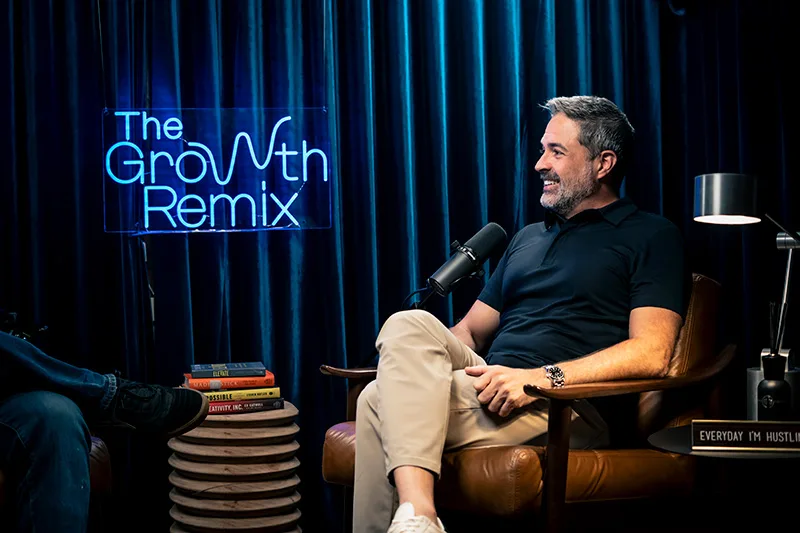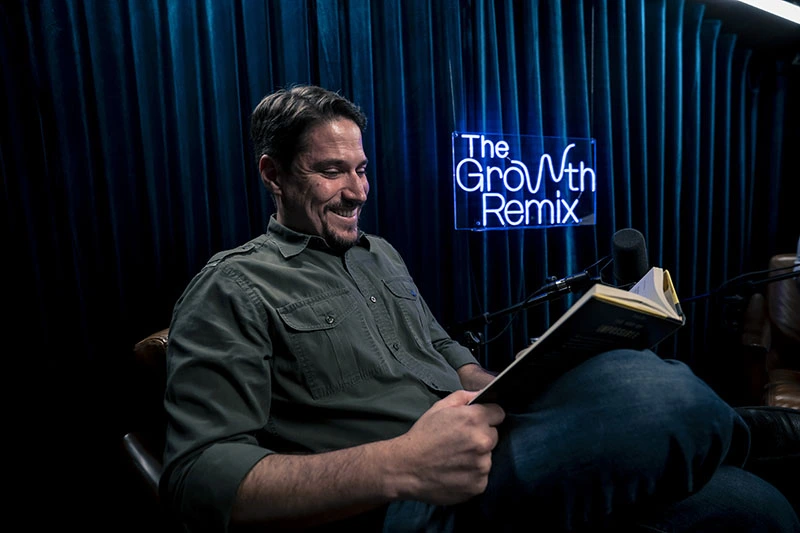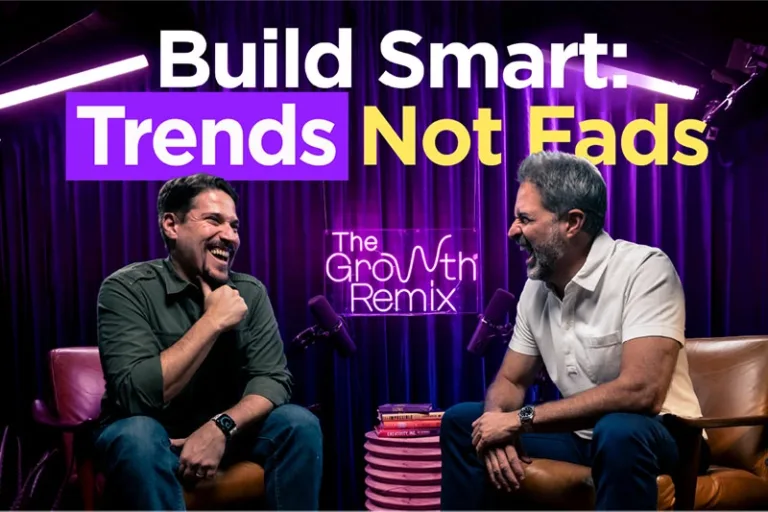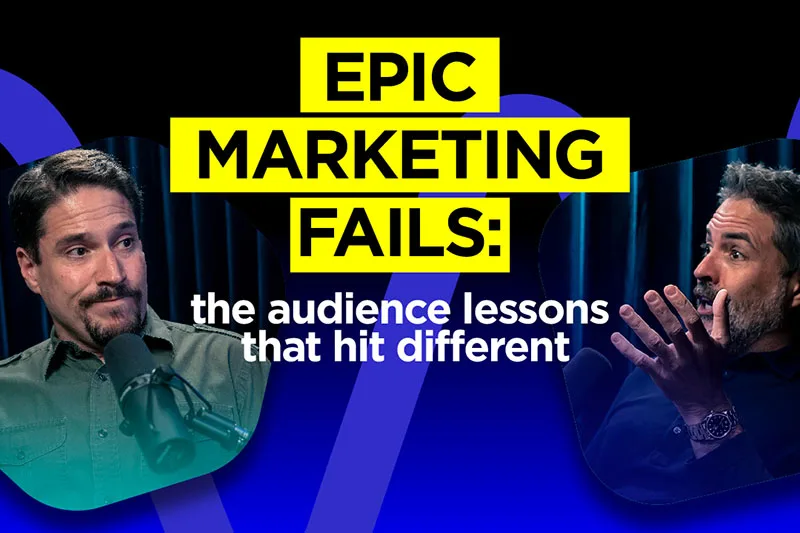Episode 2 of The Growth Remix dissects why some viral phenomena create sustainable empires while others destroy promising businesses in months.
Picture this: It’s 6 AM, coffee shop customers are “pumped up” drinking espresso while jumping to DJ music, and social media is declaring it the next big thing. But is this coffee shop party phenomenon a revolutionary business trend or a dangerous fad that could bankrupt eager entrepreneurs?
In Episode 2 of The Growth Remix, Carlos Cobián and André Carlo tackle one of entrepreneurship’s most crucial yet misunderstood challenges: distinguishing between profitable trends and destructive fads. Their analysis reveals why this distinction often means the difference between building sustainable wealth and losing everything.
The Coffee Shop Party Phenomenon: Innovation or Gimmick?
Carlos opens with honest skepticism about the viral coffee shop party trend sweeping social media. “I’ve gone to a morning brunch where there was a DJ, and I told the owner, ‘Hey, can you turn down the volume a bit?'” he admits. “For me, going to a coffee shop is about drinking my coffee peacefully.”
This seemingly simple observation reveals a sophisticated understanding of customer behavior versus viral moments. While coffee shop parties generate impressive social media engagement and drive short-term foot traffic, they fundamentally misunderstand the core value proposition of coffee consumption: a peaceful, contemplative experience.
André reinforces this perspective: “I think it’s more of a fashion than a trend. It’s a full fad.” However, he acknowledges the marketing power: “As a marketing stunt, it’s powerful. It’s combining pop-up concepts with disruption—mixing things that don’t normally mix to provoke something.”
The Framework: Marathon vs Sprint
The conversation establishes a critical framework for evaluating business opportunities:
Trends = Marathon: Long-term evolution tied to technological advancement, behavioral change, and sustainable consumer needs. These create lasting business opportunities.
Fads = Sprint: Quick bursts of viral attention without sustainable foundation. These offer short-term marketing opportunities but dangerous business foundations.
“A trend is like a marathon, and a fad is like a sprint,” André explains. “We’re going to run fast now, but it dies quickly.”
This distinction becomes crucial when entrepreneurs must decide whether to build entire business models around emerging phenomena or simply leverage them as marketing tools.
Case Study: Netflix’s Transformation from Trend to Mainstream
The hosts examine Netflix as a perfect example of trend identification and execution. “When Netflix started streaming, transitioning from VHS and DVDs that they sent to your house, that was a trend back then,” Carlos notes. “Now it’s not even a trend anymore—it’s mainstream, it’s the norm.”
Netflix’s journey illustrates several key characteristics of legitimate trends:
- Technological foundation: Broadband internet infrastructure enabled streaming
- Behavioral evolution: Consumer preference for on-demand content
- Sustainable value proposition: Convenience and selection at competitive pricing
- Market expansion potential: Global scalability
Today, Netflix, Spotify, and countless streaming services dominate because they built on genuine technological and behavioral shifts rather than viral moments.
The Apple Watch Evolution: From Niche to Necessity
Another compelling case study emerges with wearable technology. “Many people said Apple Watch wouldn’t work, that it would die,” André recalls. “But Apple, as they do with everything, saw there was a product serving a very specific group’s needs and said, ‘Wait, we can expand the customer base.'”
The Apple Watch succeeded because it:
- Built on existing fitness tracker adoption (Garmin for athletes)
- Expanded functionality beyond the original niche
- Integrated with broader technological ecosystems
- Created new behavioral patterns (paying with watches)
This demonstrates how successful companies identify narrow trends and expand them into mainstream opportunities.
The Remote Work Revolution: From Offensive to Essential
Perhaps the most relevant example for modern entrepreneurs is remote work’s evolution. “We were already in that trend before the pandemic,” Carlos explains. “Ten years ago, when we told some clients, ‘Let’s do the meeting via video conference,’ they got offended.“


The transformation of remote work from business taboo to standard practice illustrates how genuine trends often face initial resistance before achieving widespread adoption. Key factors included:
- Technology readiness: Video conferencing and collaboration tools
- Economic pressure: Need for cost reduction and talent access
- Behavioral shift: Acceptance of digital-first communication
- Crisis acceleration: Pandemic forced adoption
“Now they don’t want to meet with us in person,” André notes, highlighting how completely the landscape shifted.
Fad Hall of Fame: Learning from Failures
The episode examines several instructive fads that created temporary business opportunities before rapid collapse:
Fidget Spinners: The Perfect Fad
“My kids had a bunch of those lying around,” André recalls. These toys represented classic fad characteristics:
- Viral social media spread
- No underlying technological or behavioral foundation
- Extremely short lifecycle (months)
- Limited expansion potential
Pokémon GO: Geolocation Gaming’s False Start
“That had business implications too because I remember businesses were tying themselves to that model of moving people to geographic points with smartphones,” Carlos notes. “But that kind of faded and passed.”
Entrepreneurs who built tour companies or location-based services around Pokémon GO faced rapid obsolescence when the phenomenon died. The game’s success was based on novelty rather than sustainable entertainment value.
Bicycle Social Rides: Cultural Fad vs Fitness Trend
The hosts distinguish between “bici jangueo” (social bicycle rides) as a fad and cycling/wellness as broader trends. This nuance demonstrates how legitimate underlying trends (health consciousness) can spawn temporary cultural expressions (specific social activities) that don’t necessarily represent sustainable business opportunities.
The Wellness Trend: Sustainable with Internal Fads
Wellness represents a legitimate trend with staying power, supported by demographic shifts, health consciousness, and lifestyle changes. “We’ve seen the proliferation of yoga centers, mindfulness, outdoor exercise events, healthy food businesses,” André observes.
However, within the broader wellness trend, specific fads emerge and disappear. Vitamin IV drips and “hangover suero” represent examples of fad elements within a sustainable trend category.
This illustrates a crucial entrepreneurial insight: legitimate trends often contain fad elements that provide short-term opportunities while the underlying trend creates lasting value.
The Vinyl Revival: When Old Becomes New Again
The conversation explores vinyl records as a unique category that doesn’t fit traditional trend/fad classifications. “Vinyl was mainstream, then people changed to a digital and streaming trend, and now it’s fashionable again,” Carlos explains.
Vinyl’s resurgence demonstrates:
- Nostalgic cycles: How past technologies can regain relevance
- Quality differentiation: Analog appeal in digital world
- Collector behavior: Sustainable niche market foundation
- Cultural identity: Music consumption as lifestyle expression
“If you manage to find a niche or consumer base that sustains your business, that’s profitable, that you can grow, that has innovation potential, then that can be considered a trend,” André concludes.
The Innovation DNA: Five Characteristics for Trend Recognition
Drawing from “The Innovator’s DNA,” André outlines five critical characteristics that help entrepreneurs distinguish trends from fads:
1. Observation
Continuous environmental scanning and pattern recognition. Successful innovators constantly monitor market changes, consumer behavior, and technological developments.
2. Active Listening
Going beyond surface-level feedback to understand underlying needs and frustrations. This involves systematic customer research and market analysis.
3. Strategic Questioning
Asking the right questions about market timing, sustainability, and scalability. This includes challenging assumptions and exploring edge cases.
4. Systematic Experimentation
Testing hypotheses through small-scale pilots before major investments. This reduces risk while providing market validation.
5. Diverse Networking
Building relationships across industries and demographics to gain multiple perspectives. This cross-pollination often reveals unexpected opportunities.
The Mentorship Advantage
For young entrepreneurs lacking pattern recognition experience, the hosts emphasize seeking guidance from seasoned business veterans. “If you’re very young, the probability that you’ll think a fad is a trend is extremely high,” Carlos warns.
Experienced mentors provide:
- Historical context: Understanding of previous market cycles
- Pattern recognition: Ability to spot similarities to past phenomena
- Risk assessment: Realistic evaluation of sustainability factors
- Network access: Connections to industry experts and potential partners
Strategic Fad Utilization: Marketing Tool vs Business Foundation
Rather than completely avoiding fads, sophisticated entrepreneurs can leverage them strategically. “I see fads as a marketing gimmick. You shouldn’t discard fads, but rather say, ‘OK, I understand this is a fad, I’m going to convert it into a marketing strategy, not the core or base of my business,'” André explains.
This approach allows entrepreneurs to:
- Generate attention: Use viral phenomena for brand awareness
- Test markets: Experiment with new customer segments
- Create buzz: Build momentum for underlying business
- Maintain flexibility: Pivot quickly when fads fade
The key lies in never making fads the foundation of business models while using them as amplification tools for sustainable value propositions.
The Risk-Reward Equation
The episode acknowledges that some risk is inherent in entrepreneurship. “There are things where you can have a beautiful business model and you’re going to fail, but that’s part of the process,” André notes.


However, understanding trend vs fad dynamics significantly improves odds of success by:
- Reducing timing risk: Building on sustainable foundations
- Improving resource allocation: Investing in long-term value creation
- Enhancing adaptability: Understanding market evolution patterns
- Creating competitive advantages: Entering markets before mainstream adoption
Practical Implementation for Entrepreneurs
The conversation provides actionable guidance for entrepreneurs evaluating opportunities:
Due Diligence Questions
- What technological or behavioral shifts support this phenomenon?
- How long has similar adoption taken in adjacent markets?
- What demographic and economic factors drive demand?
- How defensible is the business model over time?
Validation Strategies
- Small-scale testing: Pilot programs before major investment
- Customer interviews: Understanding underlying motivations
- Competitive analysis: Examining similar historical phenomena
- Expert consultation: Seeking industry veteran perspectives
Decision Frameworks
- Investment allocation: Treating fads as marketing budgets, trends as business investments
- Timeline planning: Different strategies for short vs long-term phenomena
- Exit strategies: Preparing for rapid pivots when necessary
The Future of Trend Analysis
As viral phenomena accelerate through social media amplification, the ability to distinguish trends from fads becomes increasingly valuable. Successful entrepreneurs must develop sophisticated pattern recognition while maintaining agility to adapt quickly.
The hosts suggest that artificial intelligence and data analytics will provide better predictive capabilities, but human judgment regarding behavioral sustainability remains crucial.
Building on Solid Ground
Episode 2 of The Growth Remix provides a masterclass in one of entrepreneurship’s most critical skills: distinguishing between sustainable opportunities and viral distractions. Whether analyzing coffee shop parties, fidget spinners, or streaming services, the framework remains consistent: true trends combine technological capability, behavioral evolution, and sustainable value creation.
For entrepreneurs, this understanding represents the difference between building on solid foundations and constructing castles on sand. As Carlos and André demonstrate, success comes not from avoiding all risks, but from understanding which risks are worth taking and which represent preventable mistakes.
The coffee shop party phenomenon may generate impressive Instagram content, but sustainable businesses require deeper foundations than viral moments. Smart entrepreneurs will use such fads as marketing amplifiers while building their empires on genuine trends that serve lasting human needs.
Listen to The Growth Remix on Apple Podcasts, Spotify, YouTube, or your favorite podcast platform! New episodes with insights from the founders of Gravital Agency.


